AMD AM1 Kabini Part 2: Athlon 5350/5150 and Sempron 3850/2650 Tested
by Ian Cutress on May 29, 2014 2:00 PM ESTSYSMark and Scientific Benchmarks
SYSmark 2014
SYSmark is developed by BAPCo, the Business Applications Performance Corporation, which includes in its current members Intel, Dell, Lenovo, Microsoft, Samsung, Sony, and Toshiba. The latest version of SYSmark, SYSmark 2014, uses the latest software packages from Adobe and Microsoft and meshes them together into a stringent testing package that can take a couple of hours to run. The end result gives marks for in office productivity, media creation and data/financial analysis sections as well as an overall result. SYSmark uses a standard office computer (an i3-4130 with a 500GB mechanical drive, 6GB DRAM, 1080p, integrated HD4400 graphics) to provide a benchmark score of ‘1000’, and all results are compared to this. Our testing runs the processors at 1080p with integrated graphics on an OCZ Vertex 3 240GB SF-2281 based SSD.
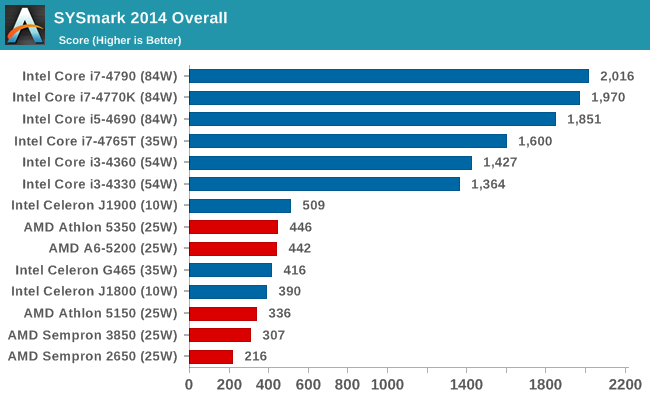
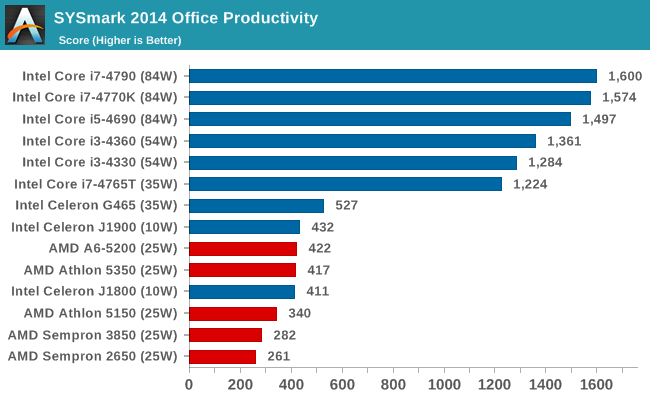
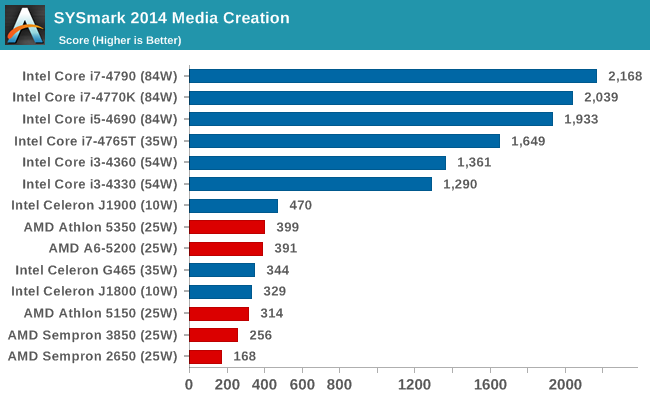
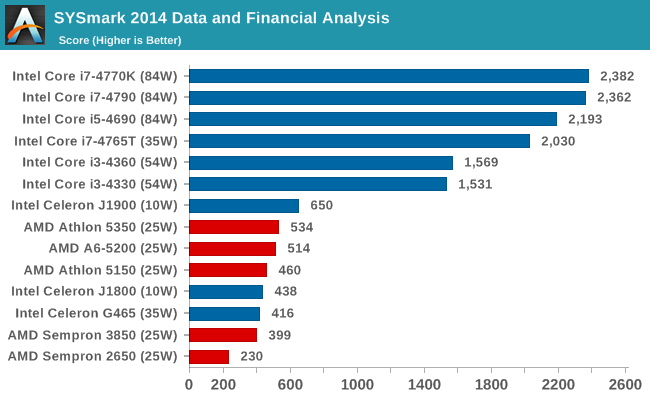
Point Calculations – 3D Movement Algorithm Test: link
3DPM is a self-penned benchmark, taking basic 3D movement algorithms used in Brownian Motion simulations and testing them for speed. High floating point performance, MHz and IPC wins in the single thread version, whereas the multithread version has to handle the threads and loves more cores.
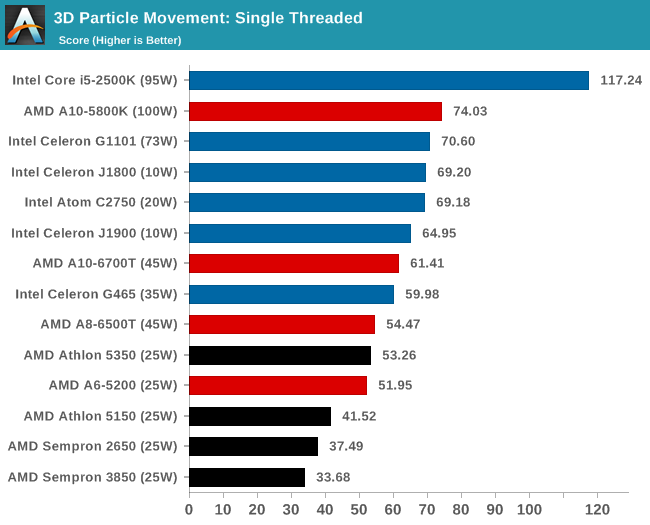
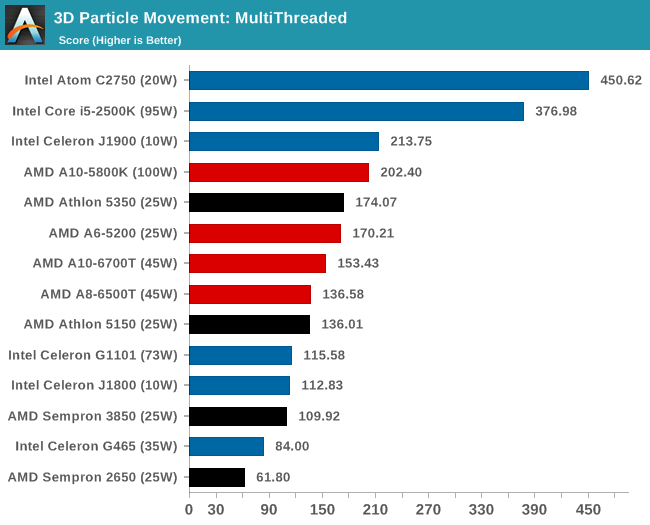
OpenCL – CompuBench: link
CompuBench is an OpenCL and RenderScript benchmark designed by Kishonti for both CPUs and any GPGPU capable device. While it offers almost two dozen tests, we select the more real-world tests in terms of fluid simulation and image analysis benchmarks.
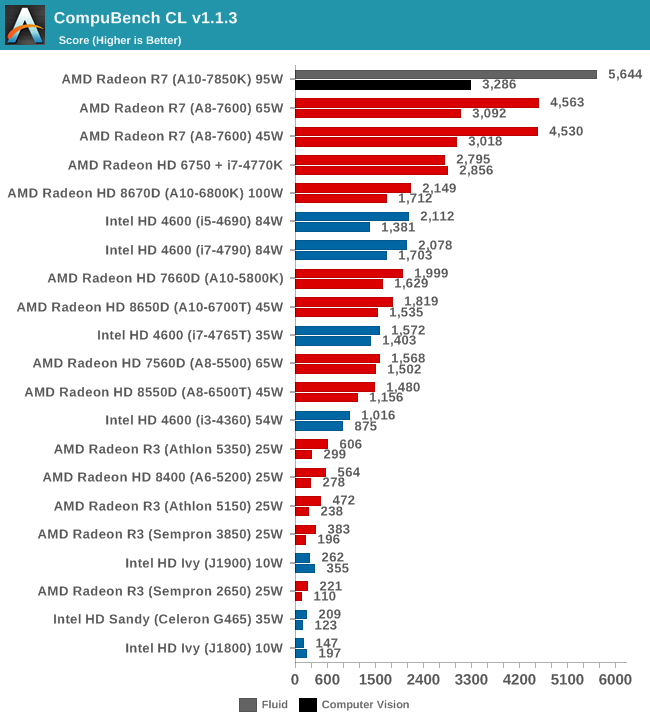










87 Comments
View All Comments
Silver47 - Thursday, May 29, 2014 - link
They are in the graphs, what are you smoking?Novaguy - Thursday, May 29, 2014 - link
I think using a weaker card for the dgpu would also have been interesting. Maybe something like an r7 270, 7750 or 7770.Also, what about Mantle benchmarks?
Novaguy - Thursday, May 29, 2014 - link
I meant r7 250, not 270... can't seem to edit via mobile.V900 - Friday, May 30, 2014 - link
No, no Mantle benchmarks... It's useless, and only serves to clutter the article.Hardly anybody cared about Mantle when it was announced... And now that we know the next version of Direct X is coming, the only people that care the slightest, are a handful of AMD fanbois.
silverblue - Friday, May 30, 2014 - link
You're entitled to your opinion. Let's look at it this way - DirectX 12 won't be here for another 18 months. Also, Mantle has been shown to perform better than AMD's own implementation of DX11 (and sometimes faster than NV's as well) and also helps with lower performing CPUs.The following link only shows the one game, but it should be enough to highlight the potential benefit of Mantle on a comparatively weak architecture such as Jaguar:
http://www.pcper.com/reviews/Graphics-Cards/AMD-Ma...
If you didn't need to upgrade your CPU to play the latest and greatest, I think you'd care, too.
formulav8 - Friday, May 30, 2014 - link
If Mantle was from NVidia or Intel you would be a bigger stooge than anyone AMD.Gauner - Thursday, May 29, 2014 - link
I think it would be far more useful for this weak systems to have a different set of game tests.No one will buy one of those to play tomb raider or bioshock but I'm guessing some people would consider buying one if you could play for example league of legends or dota2 at minimum and 720/1080p.
I understand it would mean an extra effort but right now the gaming tests don't really tell anything useful nor do they add useful information to other reviews by having an extra comparison.
Just taking into account steam games(since they are the easier ones to get data about) in the top 5 most played games daily you always have: dota2, CS:GO and TF2. Those 3 games used to run(poorly, 800x600, low detail, 20-30fps) in the old Intel GMA4500M so in my opinion they have a lot of people potentially interested in them and would run well enough in low power systems to give a useful comparison between chips.
res057 - Thursday, May 29, 2014 - link
Tests with high end games and cpu intensive tasks for processors such as these is like Car and Driver putting a Prius through quarter-mile test and comparing the results with a Corvette. Pointless.Gauner - Friday, May 30, 2014 - link
I can understand the logic behind CPU intensive tasks, even if you wont use this kind of CPUs to compress video with x264 you can watch the results and get a realistic estimation on the performance difference because the test is the same for both weak CPUs and high end CPUs.Problem with the gaming tests is that the comparison is with settings completely different from the high end tests so no parallelism there and with a set of games that no one would think to play in weak systems so there is no useful info given.
I cant look at the results and say "since tomb raider at 1280x1024 with low graphics ran at 20fps I guess league of legends will run at 1080p with medium graphics and 35fps", there are too many different points to make a comparison(AAA engine vs engine designed for low power computers, different resolution, completely different poly count and texture sizes, ...).
takeship - Friday, May 30, 2014 - link
I'm curious why no comparison with the old E-450/E-2000 Jaguar chips. Not so much for the CPU performance, but for the GPU improvements going to GCN.